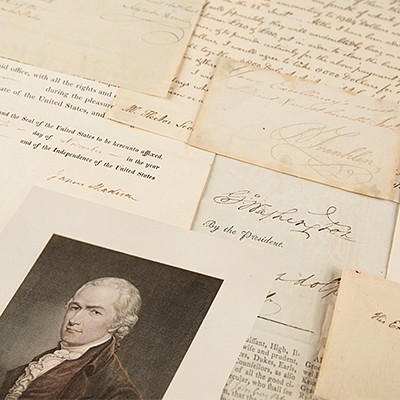John Hancock Document Signed as Governor of Massachusetts During the Revolutionary War, Appointing a Commonwealth Militia Major General as a Justice o
Two ways to bid:
- Leave a max absentee bid and the platform will bid on your behalf up to your maximum bid during the live auction.
- Bid live during the auction and your bids will be submitted real-time to the auctioneer.
Bid Increments
| Price | Bid Increment |
|---|---|
| $0 | $5 |
| $50 | $10 |
| $200 | $25 |
| $500 | $50 |
About Auction
Oct 11, 2023
RR Auction support@rrauction.com
- Lot Description
Revolutionary War-dated manuscript DS, one page, 16.5 x 13.25, December 30, 1780. As the Governor of Massachusetts, Hancock appoints Azor Orne “to be one of the Justices to keep the Peace in the General Counties of the Commonwealth of Massachusetts viz Suffolk, Essex, Middlesex, Hampshire, Plymouth, Barnstable, Bristol, York, Dukes County, Nantucket, Worcester, Cumberland, Lincoln, & Berkshire.” This was a suitable position of responsibility for Azor Orne, who had been with Hancock from the start and remained loyal and trustworthy. Signed prominently at the conclusion by John Hancock, and countersigned by John Avery as secretary. The upper left corner retains the original embossed paper seal. Impressively double-matted and framed with an engraved plate to an overall size of 26 x 23.25. In very good to fine condition, with scattered soiling and slight fading to the text. The format of this appointment is unlike any we have seen previously (with ruffles and flourishes and the recipient’s name in red ink), and a different format was soon selected for future appointments; the latter is the one commonly seen. This also represents only the second 1780 document signed by Governor Hancock that we have offered.
Massachusetts militia Colonel Azor Orne was a notable patriot, serving on one of the Committees of Correspondence formed to call to the world’s attention the grievances of the colonists. He was elected to the First Continental Congress in 1774, but had to decline, instead accepting a post on the important provincial Committee of Safety (which controlled the military stores), where he served alongside Samuel Adams and John Hancock.
On the fateful night of April 18, 1775, in company with fellow Marbleheaders Elbridge Gerry and Jeremiah Lee, Orne attended what was to prove the committee’s final pre-war meeting at Weatherby’s Black Horse Tavern just outside of Cambridge. The meeting adjourned late, and while Hancock and Adams left for nearby Lexington to sleep at Rev. Mr. Clarke’s house, the Marblehead men decided to spend the night at the tavern.
The 800 British soldiers who were on their way that night to Lexington and Concord learned of the presence of the Committee members in Cambridge, so the tavern there also became a target. When patriots learned that this was the case, in addition to Paul Revere being despatched to Lexington to warn the province leaders that the British were coming, another courier was sent to Cambridge with the same news. Orne, Gerry, and Lee were roused from their slumbers. They did not even have time to put on their clothes, but ran at once from the house and hid in a cornfield while British regulars searched the tavern looking for members of the ‘Rebel Congress.’
Nearly a year later, on January 22, 1776, an act was passed for ‘Forming and Regulating the Militia within the Colony of the Massachusetts Bay, in New England, etc.,’ which repealed all other former acts for that purpose. In accordance with this act, John Hancock, Azor Orne, and Benjamin Lincoln were chosen 1st, 2nd, and 3rd Major Generals of the militia of the colony, on February 8, 1776. In addition to his military leadership during the Revolution, Orne spearheaded the campaign as a financial benefactor, routinely loaning great deals of money to the cause.
Hancock was elected the first governor of Massachusetts under the new 1780 state Constitution, taking office on October 25 of that year. At that time, the Revolution was still ongoing and its outcome was not certain; Cornwallis’s surrender at Yorktown was a year away. Soon after, he made his initial appointments, including the first Massachusetts justices of the peace. Back then, a justice of the peace had more judicial powers than today, acting as an extension of a court of common pleas and initiating all civil cases. So men of the caliber of Orne were the recipients of these significant appointments. - Shipping Info
-
Bidder is liable for shipping and handling and providing accurate information as to shipping or delivery locations and arranging for such. RR Auction is unable to combine purchases from other auctions or affiliates into one package for shipping purposes. Lots won will be shipped in a commercially reasonable time after payment in good funds for the merchandise and the shipping fees are received or credit extended, except when third-party shipment occurs. Bidder agrees that service and handling charges related to shipping items which are not pre-paid may be charged to a credit card on file with RR Auction. Successful international Bidders shall provide written shipping instructions, including specified Customs declarations, to RR Auction for any lots to be delivered outside of the United States. NOTE: Declaration value shall be the item’(s) hammer price and RR Auction shall use the correct harmonized code for the lot. Domestic Bidders on lots designated for third-party shipment must designate the common carrier, accept risk of loss, and prepay shipping costs.
-
- Buyer's Premium



 EUR
EUR CAD
CAD AUD
AUD GBP
GBP MXN
MXN HKD
HKD CNY
CNY MYR
MYR SEK
SEK SGD
SGD CHF
CHF THB
THB













